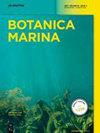水生新camarosporium aquaticum(新camaroporiaceae,斑点菌),一种来自盐沼栖息地的新型真菌
IF 1.4
4区 生物学
Q2 MARINE & FRESHWATER BIOLOGY
引用次数: 1
摘要
摘要:从英国海灵岛Kench自然保护区的一株盐生植物的漂移死茎中采集的水生新卡马孢菌被描述为新卡马孢子菌科Dothidomycetes中的一个新种。基于LSU、SSU、ITS rDNA和EF1-α的多基因座分析将这种新真菌定位为Neocamarosporium属中的一个独特物种,Neocamarosperium aesturinum是从海水中分离出来的一个姐妹。该新物种的特征是无性变形,具有pycnidial分生孢子体、doliiform、肠母细胞、退火分生细胞,分生孢子最初透明、无菌,成熟时具有纵向和横向隔膜,呈暗褐色,成熟时变为棕色至深棕色。新卡马孢子虫和夏枯草在分生孢子的颜色、分隔程度和分生孢子测量上不同。本文章由计算机程序翻译,如有差异,请以英文原文为准。
Neocamarosporium aquaticum (Neocamarosporiaceae, Dothideomycetes), a novel fungus from salt marsh habitats
Abstract Neocamarosporium aquaticum, collected from a drift dead stem of a halophyte at the Kench Nature Reserve, Hayling Island, UK, is described as a new species in the family Neocamarosporiaceae, Dothideomycetes. Multi-locus analyses based on LSU, SSU, ITS rDNA, and EF1-α placed the new fungus as a distinct species in the genus Neocamarosporium, a sister to Neocamarosporium aesturinum isolated from seawater. The new species is characterized by the asexual morph with pycnidial conidiomata, doliiform, enteroblastic, annellidic conidiogenous cells, and conidia that are initially hyaline, aseptate, with longitudinal and transverse septa when matured, muriform, and turning brown to dark brown on maturity. Neocamarosporium aquaticum and Ne. aesturinum differ in the colour of the conidia, degree of septation, and conidial measurements.
求助全文
通过发布文献求助,成功后即可免费获取论文全文。
去求助
来源期刊

Botanica Marina
生物-海洋与淡水生物学
CiteScore
4.10
自引率
4.50%
发文量
43
期刊介绍:
Botanica Marina publishes high-quality contributions from all of the disciplines of marine botany at all levels of biological organisation from subcellular to ecosystem: chemistry and applications, genomics, physiology and ecology, phylogeny and biogeography. Research involving global or interdisciplinary interest is especially welcome. Applied science papers are appreciated, particularly when they illustrate the application of emerging conceptual issues or promote developing technologies. The journal invites state-of-the art reviews dealing with recent developments in marine botany.
 求助内容:
求助内容: 应助结果提醒方式:
应助结果提醒方式:


